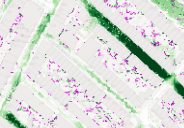The Tygron Community Forum will be discontinued on March 6th 2026, matching the release of the 2026 version of the Tygron Platform.
Click on your picture in the top right corner, go to Preferences and select your notification preferences.
Please keep in mind:
1. To only comment on the topic where the discussion is about. Do you have a new question or topic? Please start a new discussion.
2. Be kind to other users!
Results accuracy calculations Rainfall overlay: Current vs. Testrun
Hello,
I have a question about the calculations of the rainfall overlay in Tygron.
To show the effect of applying waterstorage underneath a road or parking lots, we built a measure which upgrades roads to a similar road type with attribute ‘water storage’. We wanted to show the effect when applying the storage to only one road, but also when applying storage for an entire neighborhood. The storage in the road is quite substantial, 300 liters / m2.
After applying the waterstorage to the road we expect the ‘waterstress’ overlay to show only locations where the waterstress decreases and locations where waterstress is equal. The waterstress shouldn’t increase when applying waterstorage to the roads.
However, when applying storage to a large part of the existing roads and calculating the waterstress for a 40 mm rainfall event (in 1 hour), we see small spots where the waterstress increases. Sometimes this increase is 1 mm, but we have seen examples where the increase in waterstress is 20 cm. In our project these locations primarily show in the backyards. This also affects the ‘belaste gebouwen’ overlay.
I think this behavior is caused by difference in the amount of cycles the rainfall overlay uses for the calculations of the test run. Due to the large amount of waterstorage under the roads and the large area where storage is applied, there will be significantly less water on the street. Therefore Tygron might need fewer cycles to provide accurate results. On complex surfaces where the waterstorage has no direct influence on the situation, think about the backyards, this however may cause less accurate results.
Can you provide insight on the amount of cycles Tygron uses to calculate the rainfall overlay in a test run situation? Is this related to the original calculations or is the required amount of cycles determined again after adding measures?
Because the behavior is only situational and happens on small locations, the results seem insignificant. However, we use these results to determine the chance that a building suffers waterdamage. The differences occur mainly in backyards, close to the buildings. Therefore the differences affect the results in such way, that buildings that didn’t show risk on waterdamage in the current situation, are now showing risk on waterdamage after creating more waterstorage. I’ve added a picture that shows locations where waterstress increases (blue) and decreases (green) (it's part of the original picture, because file was too big to upload).
Can you explain this behavior and advise me on how to solve or work with this issue?
Thanks in advance, Thijs



Comments
Hi Thijs,
Thanks for your elaborate comment. We will look into your questions and provide you with an answer soon!
Tygron support team
Hi Thijs,
We have had some contact by email to share your project with Support to look into it more.
As for your question on the cycles:
The amount of cycles is calculated again when applying actions or measures.
As for the use case on rainfall flooding:
Small differences in grid cell values can be expected because there is always evaporation, infiltration and exchange of water with the other cells etc.
My advise would therefore be to perform the analysis on a somewhat higher abstraction level.
Calculate for example the difference in gridvolume with TQL before and after the waterstorage is built in a backyard surrounded by houses. Create therefore some areas that are enclosed by buildings and calculate the gridvolume before and after and see if it increases.
I calculated the gridvolume in two areas and noticed that it decreased in the backyards after applying the water storage action, even though there are individual grid cells where the waterstress increases.
What you also can do with the results of your impacted buildings overlay is calculate how much it now differs from before the action was carried out. Is it just one building more and is this acceptable for your use case?
I hope this has helped you with your project!
Tygron support team